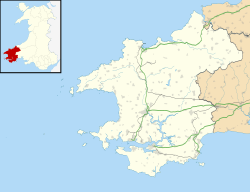History
The refinery came on stream in 1964. It was initially owned by the Regent Oil Company, a large domestic marketer of Trinidad-produced oils. [2] Regent was fully acquired by Texaco in 1956 (although the brand name was only phased out in the UK in favour of Texaco in the late 1960s).
When it first came on-stream most of the crude oil for the refinery came from the Middle East with some from Libya, Venezuela and Trinidad. Products were shipped to all parts of the UK, with 96 per cent going by ship as there was no rail link to the national rail network. [3]
Pembroke refinery also supplied fuel oil to the nearby oil-fired 2,000 MW Pembroke power station (commissioned in 1968). [3]
Chevron acquired Texaco in 2000. Valero Energy Corporation bought the refinery from Chevron in 2011. [4]
In August 1992, Texaco offered to purchase the entire village of Rhoscrowther [5] which lies immediately adjacent to the refinery. Many of the residents accepted the offer – especially after a large explosion which occurred two years later – which included their properties being purchased at market price plus reasonable expenses. Once the properties were acquired by the refinery, they were demolished. Today, only five houses, a 14th-century church and a farm are all that remain of Rhoscrowther.
The historical refining distillation capacity was as follows. [6] [7]
Pembroke refinery distillation capacity| Year | Capacity (million tonnes per year) |
|---|
| 1965 | 5.1 |
| 1972 | 7.0 |
| 1975 | 9.0 |
| 1979 | 9.0 |
| 1985 | 9.0 |
| 1990 | 9.0 |
| 1995 | 9.0 |
| 2000 | 9.25 |
| 2005 | 9.25 |
| 2010 | 10.5 |
This page is based on this
Wikipedia article Text is available under the
CC BY-SA 4.0 license; additional terms may apply.
Images, videos and audio are available under their respective licenses.

